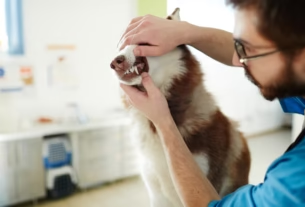Introduction
When it comes to responsible dog ownership, ensuring the safety and well-being of both the dog and those around them is of utmost importance. One tool that has been the subject of much debate is the dog muzzle. While some view muzzles as a cruel and unnecessary restraint, others recognize their value in certain situations. In this comprehensive guide, we will explore the ethical use of muzzles for dogs, discussing their benefits, potential drawbacks, and best practices for using them responsibly.
What is a Dog Muzzle?
A dog muzzle is a device that is placed over a dog’s snout to prevent them from biting, barking excessively, or consuming unwanted substances. Muzzles come in various styles and materials, such as basket muzzles, soft muzzles, and leather muzzles. It is essential to choose a muzzle that is well-fitted, comfortable, and allows the dog to breathe, pant, and drink water freely.
When to Use a Muzzle for Dogs
Veterinary Visits and Grooming
One of the most common situations where a muzzle may be necessary is during veterinary visits or grooming sessions. Even the most well-behaved dogs can become anxious or aggressive when faced with unfamiliar or stressful situations. Using a muzzle in these instances can protect the veterinary staff, groomers, and the dog itself from potential injury.
Public Transportation and Crowded Areas
In some cities, muzzles are required by law when taking dogs on public transportation or in crowded areas. This is to ensure the safety of both the dog and the people around them. Even if not legally required, using a muzzle in these situations can provide peace of mind and prevent any unfortunate incidents.
Behavior Modification and Training
For dogs with a history of aggression or biting, a muzzle can be a valuable tool during behaviour modification and training sessions. It allows the dog to participate in training exercises while minimising the risk of injury to the trainer or other dogs. However, it is crucial to note that a muzzle should never be used as a long-term solution for aggression and should always be used in conjunction with proper training and socialisation.
Choosing the Right Muzzle for Your Dog
When selecting a muzzle for your dog, there are several factors to consider:
Size and Fit
A properly fitted muzzle is essential for both comfort and effectiveness. Measure your dog’s snout length and circumference to ensure you choose the correct size. The muzzle should be snug but not tight, allowing enough room for your dog to open its mouth slightly, pant, and drink water.
Material and Style
Muzzles are available in various materials, such as leather, nylon, and plastic. Basket muzzles are often preferred as they provide better ventilation and allow the dog to pant and drink more easily. Soft muzzles, while more comfortable, may not be suitable for dogs with a history of biting as they can still cause injury through the fabric.
Comfort and Durability
Choose a muzzle that is well-padded and has smooth edges to prevent chafing or irritation. The muzzle should also be durable enough to withstand your dog’s strength and any potential chewing or scratching.
Introducing Your Dog to a Muzzle
Proper introduction and desensitisation are crucial when using a muzzle for dogs. Follow these steps to ensure a positive experience:
- Start by letting your dog sniff and investigate the muzzle without putting it on.
- Offer treats and praise when your dog shows interest in the muzzle.
- Gradually progress to touching the muzzle to your dog’s nose, rewarding them for remaining calm.
- Slowly place the muzzle on your dog for short periods, continuously offering treats and praise.
- Increase the duration of muzzle wear over time, always associating it with positive experiences.
| Duration | Treats | Praise |
| 5 seconds | High-value treats | Enthusiastic praise |
| 10 seconds | High-value treats | Enthusiastic praise |
| 30 seconds | High-value treats | Enthusiastic praise |
| 1 minutes | High-value treats | Enthusiastic praise |
| 2 minutes | High-value treats | Enthusiastic praise |
Positive Reinforcement
Using positive reinforcement techniques is essential when introducing your dog to a muzzle. Offer high-value treats, such as small pieces of chicken or cheese, and provide enthusiastic praise whenever your dog remains calm while wearing the muzzle. This will help create a positive association with the muzzle and make future use more comfortable for your dog.
Gradual Increase in Duration
Start by having your dog wear the muzzle for only a few seconds at a time, gradually increasing the duration as they become more comfortable. Never force your dog to wear the muzzle if they show signs of distress, and always supervise them while they are wearing it.
Best Practices for Using a Muzzle
Supervision and Monitoring
Whenever your dog is wearing a muzzle, it is essential to supervise them closely. Check regularly to ensure the muzzle is not causing any discomfort or irritation, and remove it if your dog shows signs of distress.
Allowing Breaks and Rewards
Provide frequent breaks from the muzzle, especially during longer periods of use. Remove the muzzle and offer treats, praise, and water to keep your dog comfortable and hydrated.
Never Use a Muzzle as Punishment
A muzzle should never be used as a form of punishment or to prevent unwanted behaviours such as barking or chewing. Doing so can create a negative association with the muzzle and potentially worsen the underlying behavioural issues.
Addressing Common Concerns
Stigma and Public Perception
One of the main concerns surrounding the use of muzzles for dogs is the potential stigma and negative public perception. Many people view muzzles as a sign of aggression or a dangerous dog, leading to discrimination and avoidance.
To combat this stigma, it is essential to educate others about the responsible use of muzzles and the various reasons they may be necessary. By promoting a positive image of muzzled dogs and their owners, we can work towards changing public perception and creating a more understanding and accepting environment.
Balancing Safety and Quality of Life
Another concern is the potential impact of muzzle use on a dog’s quality of life. Some argue that muzzles restrict a dog’s natural behaviours and can cause distress or discomfort.
While it is true that muzzles can limit certain behaviours, such as biting or eating foreign objects, they should not be used to the point where they significantly impact a dog’s overall well-being. Proper introduction, desensitisation, and using a well-fitted, comfortable muzzle can help minimise any negative effects.
It is also crucial to recognize that, in some cases, the temporary use of a muzzle can actually improve a dog’s quality of life by allowing them to participate in activities or situations that would otherwise be unsafe or off-limits.
Alternatives to Muzzles
In some cases, alternative solutions may be more appropriate than using a muzzle:
Training and Behavior Modification
For dogs with behavioural issues such as aggression or anxiety, working with a professional dog trainer or behaviourist can help address the underlying causes and develop a personalised training plan. Positive reinforcement techniques, desensitisation, and counterconditioning can be effective in modifying unwanted behaviours.
Management and Environmental Control
In situations where a muzzle may be considered, such as during veterinary visits or in crowded areas, management techniques and environmental control can sometimes be used instead. For example, scheduling appointments during quiet times, using a separate entrance, or providing a safe space for the dog can help reduce stress and minimise the need for a muzzle.
Conclusion
The ethical use of dog muzzles requires careful consideration, proper selection, and responsible handling practices. By understanding the benefits and potential drawbacks of muzzles, choosing the right type for your dog, and following best practices for introduction and use, you can ensure the safety and well-being of both your dog and those around them.
Remember, a muzzle should never be used as a long-term solution or a substitute for proper training, socialisation, and management. By working to address underlying behavioural issues and promoting responsible muzzle use, we can create a safer and more harmonious environment for both dogs and humans alike.




